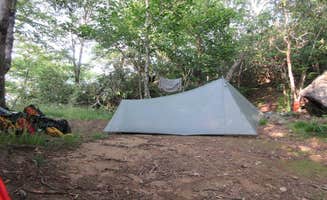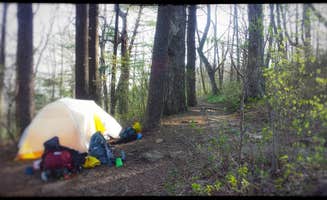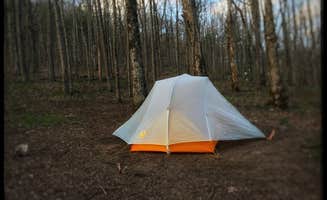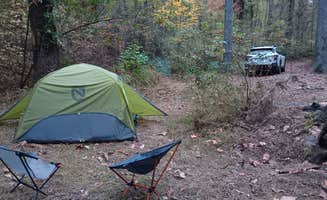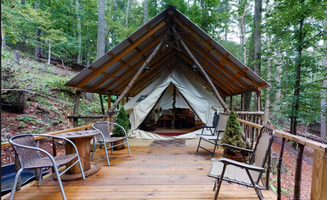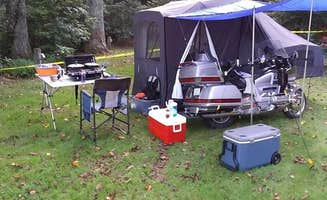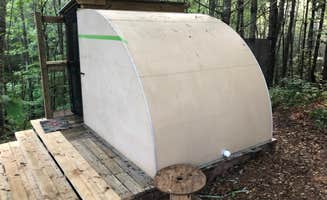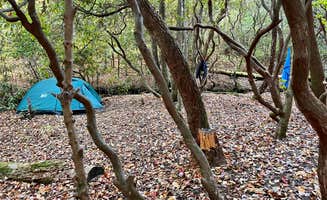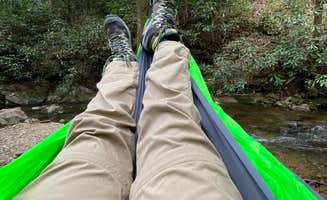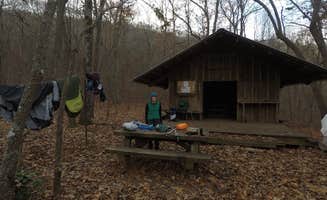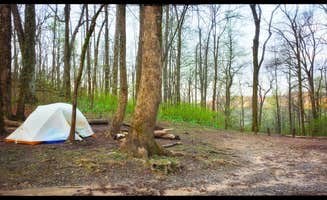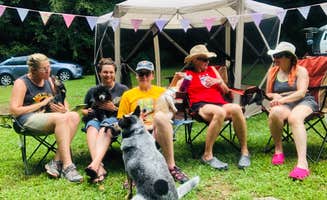The Chattahoochee National Forest surrounding Blairsville, Georgia sits at elevations between 1,600 and 4,700 feet, creating distinct microclimates throughout the camping areas. Winter temperatures frequently drop below freezing at higher elevations while summer nights cool to the 50s even during July and August. Tent sites in this region range from established campgrounds with vault toilets to remote forest spots requiring multi-mile hikes with full self-sufficiency.
What to do
Waterfall exploration: Visit Raven Cliff Falls with its 5-mile round-trip hiking trail ending at a dramatic waterfall. A camper noted, "Raven Cliff Falls trail is a 2.5 miles hike that ends at a breathtaking waterfall, but the trail doesn't quite end there. Once you arrive at the falls there's plenty of room to roam the dozens of rock structures" (Wayne H.).
Mountain summit hikes: Trek to Blood Mountain Shelter on the Appalachian Trail for panoramic views and backcountry camping. "We hiked up to Blood Mountain from the Byron Reese Trailhead. We didn't stay in the shelter and instead set up our tent near an overlook nearby. Perfect place for sunrise and sunset" (Renee B.).
Motorcycle touring: Use Two Wheels of Suchess as a base camp for riding North Georgia's winding mountain roads. The campground sits "at the convergence of many great roads. Dedicated to motorcyclists, TWO has tent sites, trees to hammock and small cabins for rent" (Mike).
Bear awareness workshops: Participate in seasonal programs at the Chattahoochee National Forest Visitor Center during summer months to learn proper food storage techniques and bear safety. "We were visited by a bear two of the nights. The bear took our neighbors dog food they forgot to pack out. So pack out all food items and trash or hang a bear bag" (D & Jess W.).
What campers like
Creek-side sites: Many campers prefer spots along flowing water at Raven Cliff Falls for natural white noise. "We were right next to Dodd Creek so we had the peaceful sounds of running water to put us to sleep at night" (D & Jess W.).
Mountainside sunrises and sunsets: Higher elevation camps offer dramatic morning and evening lighting. A camper at Blood Mountain noted: "We didn't stay in the shelter and instead set up our tent near an overlook nearby. Perfect place for sunrise and sunset. It was a little buggy until the wind picked up" (Renee B.).
Simplified camp logistics: Some sites feature unexpected conveniences. "Their food is very good too sadly, only on the weekends from Friday evening to Sunday morning" at Two Wheels of Suchess, where your "bill is on the honor system. They will not hound you about what you owe" (Joel).
Pristine night skies: The lack of light pollution makes many backcountry sites ideal for astronomy. "The views at the top of the mountain were OK better views coming off the mountain on the north side. Must see" (Jim I.).
What you should know
Site distribution system: At Woody Gap Campground, campsites are scattered in less obvious locations. One camper explains: "Frente al parking lot hay un gran espacio como una cueva y en la parte superior se puede acaparar sin tener vista directa, prácticamente si no se sube una cuesta no se ve" (Ernesto H.).
Access road challenges: Some campgrounds require high-clearance vehicles. Low Gap camping area "seems like a beautiful place but need 4wd so we couldn't get within 0.9 miles of the campground. The mud holes are deeper than they look and road is rugged with huge rocks" (Bri).
Wildlife encounters: Bears remain active throughout the region, with campers reporting: "We were visited by a bear two of the nights. The bear took our neighbors dog food they forgot to pack out" (D & Jess W.).
Reservation systems: Most forest service sites operate first-come, first-served, especially on higher traffic weekends. "Is a great location when it's not near the holidays or when everyone is off since the location will fill up quickly. Campsite are first come first serve" (Alicia B.).
Tips for camping with families
Easy access sites: Look for walk-in options under 0.5 miles from parking areas with amenities. "Our spot was about a quarter mile from the parking area which has public restrooms available, and we were right next to Dodd Creek" (D & Jess W.).
Shorter trail options: Select accessible day hikes for children of various ages. "One mile hike to the top but it's worth it! Plenty of room to camp and fires are aloud. It is on the AT so primitive spots only" (Alex K.).
Resource planning: Bring adequate water for drinking and cooking since many primitive sites lack potable sources. "Water is no problem with the entire trail being directly on a solid flowing stream" at Low Gap according to Joshua G.
Weekend activity schedules: Time visits to coincide with campground events at established areas. Two Wheels of Suches offers meals "Friday night through Sunday morning, as well as breakfast on Monday morning. Fire wood and ice available 24 hours" (Brian F.).
Tips from RVers
Size restrictions: Most forest roads limit RV access to smaller units under 26 feet. "We stayed in the parking lot in our small rig. (Under 26 ft) we had our super quiet generator running and had no issues" at Mountain Crossings Hostel (Abraham B.).
Facilities access: RV campers can sometimes use services at hiker-focused locations by paying day-use fees. "You can still make use of the shower and laundry for a small fee" at Mountain Crossings, notes one visitor (Art S.).
Camp store amenities: Some locations offer supplies specifically for RVers. "The store has anything you could possibly need for re-supply, which makes it totally awesome! Gear (packs, sleeping bags, shoes, socks, etc), cooking supplies (food, stoves, fuel), books, water bottles, you name it!" (Amy G.).
Road condition awareness: Forest service roads deteriorate seasonally, particularly after heavy rain or winter weather. "I would also recommend not going after it has rained or snowed, or if you do, leave your vehicle on the trail and unpack from there" (Nick).


